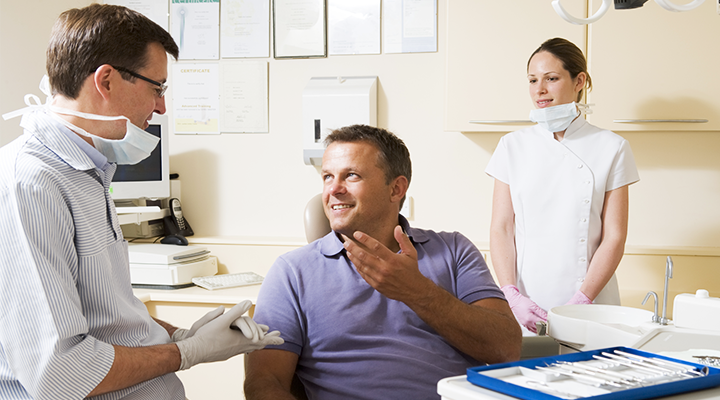Dental Visits Decoded: Are Dental Cleanings Necessary?
Posted Jun 2019
By Delta Dental of Arkansas
Tagged dental cleaning, overall health, oral health, Benefits, dental plan
Dental Visits Decoded: Are Dental Cleanings Necessary?
Posted June 2019
Revised February 2022

Love ‘em or hate ‘em, those semi-annual dental cleanings?
Some people cherish the smooth, polished feeling of their teeth, but others dread the experience—perhaps the fear of the unknown?
Before we flush out all details of professional teeth cleanings, let’s brush up on why they are necessary.
Why Regular Dental Cleanings and Visits?
Your daily brushing and flossing may be impeccable, bravo. But despite your meticulous care, food particles may still hide in the tiny nooks and crannies of your teeth, especially if you have some crooked teeth. That can lead to the buildup of plaque and tartar, which can cause gum disease and other health problems (more info below).
Only a professional has the right tools and know-how to remove those deposits to help prevent dental ailments. The dental professional will also examine your teeth, gums and mouth for any signs of developing oral health issues.
What Happens During a Professional Teeth Cleaning and Preventive Dental Care Visit?
If it’s been more than six months since you’ve found yourself in a dental chair, it’s time to schedule your next appointment. Here’s what to expect.
1. A Professional Cleaning Done in 3 Steps
Typically, your dental visit will begin with a teeth cleaning performed by the dentist, a hygienist or certified dental assistant.
- They will use special tools and instruments such as scalers to scrape tartar and plaque from under and below your gum line and the surface of your teeth. It’s common to have at least some buildup. If you’re sensitive to dental cleanings, ask your dentist about ultrasonic scalers that break up the tartar with vibrations and water.
Once the stains and tartar have been removed, your dentist or hygienist will use a tool that squirts water into your mouth to rinse the particles away. A wand with suction is applied to remove the excess water and debris out of your mouth
- Then, every surface of your teeth will be polished with a gritty paste and a polisher. Polishers are handheld, air-driven electrical devices with a rotating head. Often, you get to pick the flavor or alert the dentist to use a paste formulated for sensitive teeth.
- A final flossing removes the last debris from between your teeth.
2. X-rays Uncover the Invisible
The visit may continue with a set of x-rays if ordered by the dentist. Dental x-rays expose structures and conditions not visible to the bare eye, such as wisdom teeth, early signs of cavities, fractures and bone loss. X-rays are painless and are recommended for most patients once a year.
3. A Periodontal Screening Evaluates Your Gums
The dentist or dental hygienist may choose to perform a periodontal screening next to check for inflammation of your gums and assess the health of your supporting gum and bone structures.
This test can be uncomfortable if you have gingivitis because it can make your gums more sensitive and swollen. But it’s an important indicator of your overall gum health, so your dentist can recommend the best treatment options. If left untreated, periodontal disease can lead to tooth loss.
If your gums are healthy, the screening shouldn’t cause any discomfort.
4. The Dental Exam
Using small instruments and a mirror, the dentist will carefully examine your gums, soft palate, throat and neck to check for abnormalities. Regular dental exams are the best way to discover early signs of tooth decay, gum disease, oral cancer and other issues. He/she will also
- review the x-rays, if applicable,
- discuss your overall oral health
- recommend and demonstrate additional oral hygiene habits or changes if necessary, and
- explain any dental work you might need.
That’s it for the dental exam and professional cleaning. But we alerted you to more information about plaque and tartar and why it’s vital to have them removed professionally.
Here we go.
What’s the Deal with Plaque and Tartar?
Plaque forms naturally in the mouth. It’s a sticky film of bacteria that covers the surface of your teeth. When interacting with the foods or drinks you consume, especially sugars or starches, the bacteria produce harmful acids that attack your tooth enamel. These acid attacks can last 20 minutes or more after you’ve finished eating! It wears down tooth enamel over time, promoting decay and other complications.
If not removed, plaque can harden into tartar, also called calcified plaque. Over time, it can get so hard that it feels like a piece of shale or cement. At this point, brushing alone won’t remove it.
And it gets worse.
Plaque can build up on top of the tartar, causing irritated, swollen, bleeding gums and possibly, gum disease. It also increases your risk for a host of general health issues, including heart disease, arterial blockage, stroke, glaucoma, and dementia, just to mention a few.
Say Yes to the Teeth Cleaning
Did we make our case?
If you were wondering, “Are regular teeth cleanings necessary?” your answer should be a resounding yes.
Regular cleanings and preventive dental care will keep your smile healthy. They will also help control your out-of-pocket costs for dental and health treatments by detecting and treating emerging issues before they require more involved and expensive treatments.
Do your little ones need convincing? Show them this kid-friendly video about the importance of regular teeth cleanings.
How Much Do Dental Cleanings Cost?
Smile: With dental insurance, your regular dental cleanings and preventive care visits are typically covered at little to no out-of-pocket expense to you.
If you currently don’t have dental insurance, check out our competitive rates for individuals and families. Or, if you’re a business owner, talk to us about our group plans.
And use this handy tool to find a dentist in your area.

